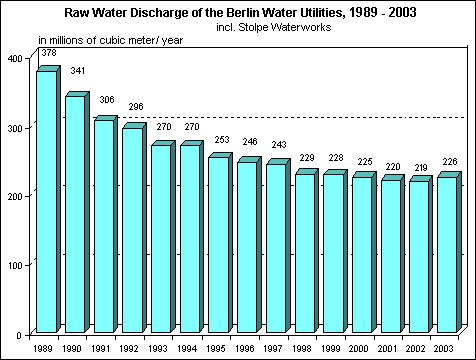The present map describes the groundwater situation of the main aquifer by means of the violet coloured groundwater isolines and the blue coloured of the Panke Valley aquifer in the North East of Berlin. These show the piezometric surface area of the unconfined and confined groundwater (see also Fig. 3). In areas with no main groundwater aquifer or with an isolated main groundwater aquifer of low thickness no groundwater isolines are displayed. Those areas are defined with dots.
The map basis is the General Map of Berlin, 1: 50,000, in grid format with an underlayed geological outline for the Berlin state area. In addition, the appropriate supporting points (groundwater measuring points, surface water levels) as well as the individual waterworks are indicated, with their wells and water conservation areas.
Hydrogeologic Situation
On the plateaus, the main aquifer is extensively covered by the glacial till and bolder clay (aquitards) of the ground moraines. Wherever the piezometric surface of the main aquifer lies within this aquitard, groundwater conditions are confined. This may at times result in the formation of perched groundwater in sandy areas above the glacial til (see also Fig. 3). It may ascend to the surface after extreme precipitation.
On the Barnim Plateau to the north, an independent coherent bigger aquifer has developed in the Panke Valley. It is located over the main aquifer, which is covered by the glacial till of the ground moraine (see also fig. 7). In the present map, this aquifer is indicated by own groundwater isolines (blue). The floating direction of this groundwater also runs from northeast to southwest. A spur of the glacial till toward the Warsaw-Berlin Glacial Spillway creates an interlock of the Panke Valley aquifer with the main aquifer there.
Hydraulic Situation
As a rule, the groundwater incline in Berlin is oriented from the Barnim and Teltow Plateaus and the Nauen Plate toward the receiving bodies, the Spree and Havel Rivers.
Depression cones have formed around the wells at the waterworks; during the measurement period, they have sunk the groundwater surface below the level of the neighboring surface waters: Thus, in addition to inflowing groundwater from the shore side, the water pumped here also includes groundwater formed by infiltration from these aboveground waters (bank-filtered water) (see also Fig. 4).
However, in May 2003, the phreatic surface, which has been lowered in Berlin by drinking-water discharge over the past hundred years, was, all in all, compared to 1989 at a relatively high level, as it had been during the previous eight years. The reason for this is the reduced raw-water discharge by the Berlin Water Utility. Five smaller Berlin waterworks (Altglienicke, Friedrichsfelde, Köpenick, Riemeisterfenn und Buch) discontinued their production altogether during the period between 1991 and 1997 were closed during the period between 1991 and 1997: Altglienicke, Friedrichsfelde, Köpenick, Riemeisterfenn and Buch. In addition, drinking water production at the two waterworks Johannisthal and Jungfernheide was discontinued temporarily since September 2001; at the latter, the same was true for artificial groundwater recharging. In the context of groundwater management by the Senate Department for Urban Development, groundwater is, however still discharged at both locations, so as not to endanger current local waste disposal and construction measures.
The overall discharge of the waterworks for drinking water purposes has dropped by over 40% in Berlin during the past 14 years (Fig. 9). In 1989, 378 million m3 were discharged, as opposed to 219 million m3 in 2002. In 2003 the discharge increased lightly again to 226 million m3 because of the dry summer.

